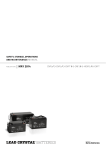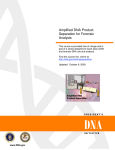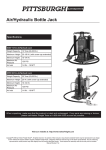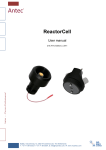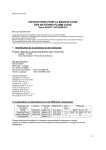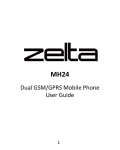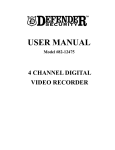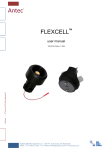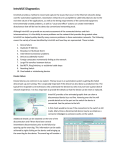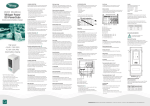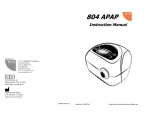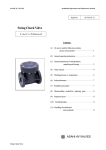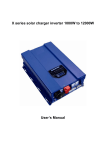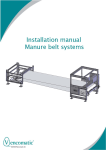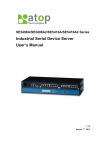Download User Manual
Transcript
Valve Regulated Lead Crystal Battery Energy Storage Cells User Manual www.bettabatteries.com [email protected] 1. Introduction The patented lead crystal battery technology is based on intense research of the defects and operating characteristics of the lead acid and lead gel batteries. We developed our own trade secret SIO2 composite electrolyte to replace the traditional sulphuric acid electrolyte commonly used in acid and gel batteries. By using our own advanced patented battery manufacturing technology and combining it with the new SIO2 composite electrolyte, we developed a much more superior battery replacement. By using the innovative new patented composite lead crystal electrolyte technology (our special formula) to completely replace the traditional sulphuric acid, it brought a great change to the battery product’s internal and chemical structure. During initial charging cycles, the liquid composite electrolyte reacts with the lead plates which cause the electrolyte to crystallize. The crystallized electrolyte fixes to the active material on the plates, enhancing the channel for ion exchange, effectively overcoming loss of moisture, plate sulphation and loss of active material. A superior resistance to low temperatures, over charging and over discharging are results of the new chemical structure inside the lead crystal batteries. This effectively multiplies the product’s service and cycle life. The CNFJ range is specially designed for alternative energy storage. It accepts a wide range of charging currents and does not rely on high currents to start and maintain the chemical reaction, making it the perfect storage battery for solar and wind generators that deliver intermitted charging at variable and interrupted currents. 2. Product Features The birth of the lead crystal battery is a revolutionary technological breakthrough in the battery industry. It solves most defects of lead acid and gel batteries such as serious environmental pollution, low fast charging ability, plate sulphuric acid sulphation, short cycle life and low temperature performance ability are amongst a few. A lead crystal battery combines all the advantages of long cycle life, high efficiency, low and high temperature resistance, low internal resistance and environmental safety to make it a much more superior product. 2.1. Structure characteristic 2.1.1. Special Electrolyte Composition By using a unique blending technology, we are able to combine a variety of inorganic salts and organic substances to co-ordinate a combined reaction to improve the reaction ability between the electrolyte and active material on the lead plates. The electrolyte prevents the active material from becoming brittle and falling of the plates, improving the cycle life. After several charge and discharge cycles the liquid electrolyte transforms into a crystallized state leaving no free liquid electrolyte in the battery. This opens a wide range of installation applications, since the risk of electrolyte leakage is eliminated. This reaction also improves the products safety making it less harmful to installers and users alike. 2.1.2. Special Manufacturing Process Using pressure filling technology in combination with patented gravity filling containers to fill the batteries with electrolyte and the patented terminal connecting equipment, these improvements ensure a much more even distribution of electrolyte in each cell further enhancing the performance of the batteries and increasing the efficiency. 2 www.bettabatteries.com [email protected] 2.2. Performance Characteristics 2.2.1. Long service life Twice as long as regular lead acid and gel batteries 2.2.2. Deep discharge ability Can be discharged to 0 volt and be recovered under normal charging conditions to 100% capacity within 2 cycles. 2.2.3. Extreme environmental temperature resistance Can be cycled in -40°C to +65°C conditions and used as normal. It performs especially well in the low temperature ranges. 2.2.4. Environmentally friendlier Classified as non-dangerous, non-explosive and non-radioactive goods by various governmental institutions. 3. Working Principle The main electrochemical reaction during the charge and discharge process of the lead crystal battery: PbO₂ + 2H₂SO₄ + Pb Discharge ← → Charge Lead dioxide + Diluted sulphuric acid + Lead Positive Plate Composite Negative Plate Active Material Electrolyte Active Material PbSO₄ + H₂O + PbSO₄ Lead sulphate + Water + Lead sulphate Positive Water Negative Discharge material Discharge material When discharging, the positive and negative active material reacts with the acidic element of the electrolyte and becomes lead sulphate and water, causing the acid density to decrease. When charging, the acid that concentrated in the positive discharge material (during discharge cycle) is released back into the electrolyte. At this time the lead sulphate in the positive and negative plate transforms in to lead dioxide and a spongy type of lead which causes the acid density in the electrolyte to increase. With normal lead acid batteries, after charging or prior to charge completion, all the charging current is used for electrolyses of the moisture in the electrolyte. The positive plates release oxygen and the negative plate hydrogen gas. If the gas recombination efficiency of the battery is low, a large percentage of the gas will escape leaving less moisture in the battery after every charge. This action causes the electrolyte content to decrease due to water loss, raising the acidity in the battery and shortening the life of the battery. This is known as late charge fluid loss phenomenon. Lead crustal batteries, besides the regular chemical reaction, the composite electrolyte has various additives that participate in the electrochemical reaction. The additives inhabit the oxygen and hydrogen gas during the charging cycle increasing the batteries recombination rate. This in turn reduces the water loss during and after charging. When discharging, the lead sulphate can be totally transformed back into active material, prolonging the battery’s use life. The lead crystal group of batteries uses a new advanced type of AGM material as a separator. The AGM has much higher electrical conductivity, heat resistant and acid resistant abilities than standard AGM on the market. The crystallized electrolyte in combination with the AGM can effectively protect the 3 www.bettabatteries.com [email protected] plates and prevent the active material from falling off during use. The electrolyte is completely absorbed and stored in the AGM. Since the AGM is completely saturated with electrolyte then crystallized, no free liquid electrolyte will be present in the battery. The battery can now be used in various directional positions without leaking. 4. Specifications 4.1. Product specification and model identification method 6 - CN FJ - 120 Rated capacity in Ah (Amp hours) Valve controlled, sealed lead crystal storage cell Energy storage battery Number of cells 6 = 12 volt, 3 = 6 volt 4.2. Model specification table 10hr Discharge rate Model Number Rated Voltage V I10/A 3-CNFJ-10 6-CNFJ-10 6-CNFJ-22 6-CNFJ-24 6-CNFJ-28 6-CNFJ-40 6-CNFJ-55 6-CNFJ-65 6-CNFJ-90 6-CNFJ-100 6-CNFJ-120 6-CNFJ-150 6-CNFJ-180 6-CNFJ-200 CNFJ-300 CNFJ-500 CNFJ-800 CNFJ-1000 CNFJ-2000 CNFJ-3000 6 12 12 12 12 12 12 12 12 12 12 12 12 12 2 2 2 2 2 2 1 1 2.2 2.4 2.8 4 5.5 6.5 9 10 12 15 18 20 30 50 80 100 200 300 Rated Capacity Ah 10 10 22 24 28 40 55 65 90 100 120 150 180 200 300 500 800 1000 2000 3000 Outer dimension ±2mm 120hr Discharge Rate End Voltage V 5.4 10.8 10.8 10.8 10.8 10.8 10.8 10.8 10.8 10.8 10.8 10.8 10.8 10.8 1.8 1.8 1.8 1.8 1.8 1.8 I120/A 0.12 0.12 0.22 0.24 0.28 0.48 0.55 0.65 0.9 1 1.2 1.5 1.8 2 3 5 8 10 20 30 Rated Capacity Ah 14.4 14.4 26 28 34 48 66 78 108 120 144 180 216 240 360 600 960 1200 2400 3600 End Voltage V 5.55 11.1 11.1 11.1 11.1 11.1 11.1 11.1 11.1 11.1 11.1 11.1 11.1 11.1 1.85 1.85 1.85 1.85 1.85 1.85 L W H 151 151 181 185 175 198 229 348 306 408 408 486 522 522 176 244 410 475 491 712 50 99 76 105 166 166 138 167 169 174 174 170 240 240 154 175 175 175 351 353 102 105 172 135 125 172 220 175 240 235 235 241 244 244 365 365 366 365 383 382 Weight kg 2.0 4.2 6.9 7.7 9.0 14.2 18.4 22.0 28.0 33.0 37.0 45.0 60.0 62.0 22.0 32.5 55.5 65 130 192 5. Product standards Lead crystal battery products are manufactured to meet the following national and international standards and are manufactured under the ISO 9001 system. GB/T22473-2008 lead-acid energy storage battery GB/T19638.2-2005 fixed type valve-controlled sealed battery Q/TDZG05-2010 fixed type valve control sealed lead crystal battery BS 6290 part 4 , Telcordia SR 4228, Eurobatt guide, UL, IEC-60896-21/22 4 www.bettabatteries.com [email protected] Chapter 2: Technical characteristics 1. Discharge characteristics 1.1. Battery capacity definition Batteries under certain discharge conditions will release a certain amount of current. This amount od current released is called the capacity. The symbol used to identify the capacity is “C”. The commonly used unit of measure is Amp Hours (Ah). 1.1.1. The battery capacity The battery capacity can be defined in two parts, namely rated capacity and actual capacity under different discharge conditions. The actual capacity of the battery under certain discharge conditions is calculated by the current (A) multiplied by the discharge time (h). The resulting unit is Ah. 1.2. Influencing factors on the battery capacity 1.2.1. Discharge rate to influence the capacity The battery discharge rate uses rated hours to determine the discharge time. This time is influenced by the amount of current drawn from the battery. If the discharge current increases, the discharge time will decrease and also affect the rated capacity. Hour rated discharge: Rate of discharge: C10 = 10 hour rated capacity (Ah) C120 = 120hour rated capacity (Ah) 1C = 1 multiplied by the 10 hour rated capacity used for the discharge current (A) 0.01C = 0.01 multiplied by the 10 hour rated capacity used for the discharge current (A) The curve graph below indicates different constant discharge currents over time of discharge at a temperature of 25°C and its effect on terminal voltage. 5 www.bettabatteries.com [email protected] 1.2.2. The influence of temperature on the capacity In Figure 1 you will notice the effect of temperature on the capacity of the CNFJ series lead crystal batteries. To calculate the capacity of the battery when the environmental temperature is not 25°C, the below formula is used: Ct = the actual capacity at a certain temperature t = the environmental temperature at the time of discharge (°C) Capacity(%) K = the temperature coefficient (10 hour rate coefficient is 0.006) 120 100 80 60 40 20 0 -40 -30 -20 -10 0 10 20 30 40 50 60 Temperature(℃) Figure 1: CNFJ series lead crystal cell relationship between discharge capacity and temperature. 1.2.3. Discharge termination voltage The termination voltage refers to the battery voltage dropping during discharge and falls to the minimum working voltage required for operation. The termination voltage and the discharge current are closely related. Generally during high current discharge the termination voltage of the battery should be set lower. During long term operation at small discharge currents, the battery will form a thin layer of sulphation on the plates, increasing their size. This could cause deformation af the active material and cause it to fall off the plates. To prevent this and also to protect the battery during small current operations, the termination voltage should be set higher. Over discharging below the termination voltage should be avoided since the over discharging could only gain a small amount of additional capacity, but drastically reduce the battery’s service life. 6 www.bettabatteries.com [email protected] The below table indicates recommended termination voltages at different rates of discharge for the CNFJ range. Discharge termination Discharge current(A) voltage (V/Cell) Below 0.05C or non constant 1.9 discharge Equal/close to 0.05C 1.85 Equal/close to 0.1C 1.8 Equal/close to 0.2C 1.75 0.2C ~ 0.5C 1.7 0.5C ~ 1C 1.6 1C ~ 3C 1.5 Above 3C 1.3 1.2.4. Self-discharging of the lead crystal batteries Lead crystal batteries with the use of our unique crystal composite electrolyte and alloy grid plate technology, efficiently reduces the battery self-discharge consumption. At a constant 25°C environment, the batteries can be kept on a shelf for more than one year without constant top up charging and the battery will maintain over 85% of its rated capacity. The self-discharge characteristics of the battery change with environmental temperatures. The higher the temperature the higher the self-discharge, so the batteries should not be stored in an environment that is subjected to high temperature conditions for long durations of time. Storage Capacity (25°C) 7 3 months 95% 6 months 90% 1 year 85% www.bettabatteries.com [email protected] 2. Charging characteristics 2.1. Charging conditions are the key factors that affect battery life and functionality The CNFJ range of lead crystal batteries should be charged using constant voltage for both floating and cyclic charge applications. 2.2. The relationship between charge voltage and environmental temperature The battery benchmark temperature setting should be assumed to be 25°C. Under different environmental temperature conditions a temperature compensation coefficient of -3mV/°C/Cell should be applied to the charging equipment. This equipment’s voltage stability factor should be ±1% or higher. 2.3. Equipment setting During the initial charge and discharge cycles the depth of discharge, discharge current, operating temperature and time of discharge should be recorded. Equipment must then be recalibrated to the recorded parameters as to ensure longer life of both the batteries and the equipment. After complete discharge, the battery should periodically be fully charged and discharged for at least two complete cycles to ensure full recovery of the battery’s capacity. The abovementioned results should be recorded and again adjustment should be made to the equipment if necessary. 2.4. Float charging applications For applications that is constantly connected to the electrical grid and where the batteries are in constant charging state and only discharged when there is a break in or loss of grid supply, the charging equipment should be set to the float charging mode. The equipment should be set and monitored so that strict control can be maintained over charging to ensure a constant charging voltage and current. Recommended floating charge voltage should be between 2.25 – 2.3V/Cell and the floating current should be between 0.005 – 0.01A. In long term float charging applications, a six month balanced charge and discharge should be performed as part of battery maintenance, where the balanced cycles should be no more than 8 – 12 hours in duration. During the initial charge and discharge cycles on new installations the charge current should be limited to 0.1C – 0.25CA (not to exceed 0.3CA) and the temperature not more than 35°C. During this stage of operation if an increase of temperature is noticed the charge current should be reduced. 2.5. Charging characteristic curve The below curve graph shows typical charge characteristics of the lead crystal batteries. 8 www.bettabatteries.com [email protected] Chapter 3: Battery Installation 1. Installation method an sequence 1.1. After the batteries are unpacked, check for any visible damage to the product. 1.2. Please read this manual before installation to ensure correct installation according to required application and equipment settings. 1.3. Ensure that the batteries remain in the shipping packaging until it arrives on the installation site. When the batteries are handled please take care not to lift the batteries by means or the terminals to avoid damage to the internal seals. Always lift the batteries by the supplied handles or from the bottom of the batteries in the event that the battery is not designed or supplied with the required lifting handles. 1.4. Before connecting the equipment to the batteries, use a piece of fine grit sandpaper to sand the contact area of the terminal and the connecting lug. This will ensure good contact between battery and lug and reduce the risk of oxidation. 1.5. When there are multiple batteries connected together in a group (series or parallel), ensure that the voltage of the batteries in the group match prior to connecting. Ensure the connections on the batteries are secure and the configuration is according to the voltage required to operate the equipment. Before connecting the load, charge the batteries to a state of full charge to ensure all the batteries are on the same level. At this point it is safe to connect the batteries. 2. Matters that need attention during installation 2.1. Ensure that all heating and cooling ducts are directed away from the batteries. The installation site should be kept clean, dry and well ventilated at all times. Avoid installing the batteries in direct sunlight, away from a heat source, organic solvents and corrosive gas to ensure longer battery life and to prevent accidents. 2.2. All the lead crystal batteries are fully charged prior to shipping to activate the crystallization of the electrolyte in the batteries. Care should be taken when handling the batteries during transport and prior or during installation to prevent short circuit and reverse connection in order to avoid damage to the equipment and harm to people. 2.3. Because of high voltage and the risk of electrical shock, the batteries should be handled with great care during transportation and when being installed. Electrically insulated equipment and clothing should be used/worn when working with or connecting batteries. 2.4. Smudgy, oily and loosely connected connections could cause contact problems and lead to faults on the equipment. Ensure that all contacts are clean from oil and grease and that all connections are securely fastened. Terminals should be torque to individual battery specifications, but not exceed 15N.m. Excessive tightening will cause damage to the thread on or inside the battery terminal. Terminal connections should be checked periodically during the life of the battery to ensure that there are no loose connections. 2.5. Ensure that the batteries are connected in the correct way. Ensure that reverse polarity are eliminated by connecting positive to positive and negative to negative on the equipment. Also ensure that the correct size of wire diameter is used according to current drawn requirement. If incorrect wires are used, it will heat rapidly and cause damage to both the battery and the equipment that it is connected to. 3. Correct use and maintenance 3.1. The batteries are designed for a usage environment to operate in extreme environmental temperatures ranging from -40°C - +65°C. Yet, most installations and best recommended environmental temperatures for use are -5°C - +35°C and a relative humidity of 95%. The CNFJ range of batteries can be used in both float and cyclic charge applications at different environmental conditions. 9 www.bettabatteries.com [email protected] 4. Charge and discharge regulations 4.1. The CNFJ range of batteries should be charged according to the specified voltages and currents indicated in chapter 2. 4.2. The CNFJ range of batteries should be discharged according to the termination voltage specified in chapter 2 and in accordance with the equipment requirements. This will ensure long life of both the battery and the equipment. 5. Battery maintenance 5.1. Perform an inspection of the batteries prior to installation. 5.1.1. Check for damage to ABS plastic shell 5.1.2.Check batteries open circuit voltage and calculate the per cell voltage if the voltage is less than 2.1V/Cell. The batteries should be charged individually to correct the balance. 5.1.3.Make a battery maintenance and operation file and record all relevant information during the life of the battery. 5.2. Operating maintenance 5.2.1.Monthly inspection and maintenance Content Method Inspection standard Solution Adjust voltage = charging and discharging The total voltage Equipment should be Total voltage = charging when the Battery is calibrated with an deviation of and discharging voltage charging and no more than 0.5 volt before x quantity of batteries in discharging testing batteries in a group the group voltage × quantity of batteries in the group, replace defective battery/ies if individual charging does not bring the voltage back required level Use the voltmeter to Controller measurement the controllers Check if the results meet Charge and output voltage, highest charge the required discharge voltage voltage and over discharge specifications Adjust the controller voltage parameters protection voltage Use the ammeter to Controller Charge and discharge current measurement the controllers output current, highest charge current and over Check if the results meet the required specifications discharge protection 10 www.bettabatteries.com [email protected] Adjust the controller current parameters to 5.2.2.Six monthly maintenance and inspection Content Method Inspection standard Solution Adjust voltage = charging and The total voltage Equipment should be Total voltage = charging when the Battery is calibrated with an deviation of and discharging voltage charging and no more than 0.5 volt before x quantity of batteries in discharging testing batteries in a group the group discharging voltage × quantity of batteries in the group, replace defective battery/ies if individual charging does not bring the voltage back to required level Use the voltmeter to Controller measurement the controllers Check if the results meet Charge and output voltage, highest charge the required discharge voltage voltage and over discharge specifications Adjust the controller voltage parameters protection voltage Use the ammeter to Controller Charge and discharge current measurement the controllers output current, highest charge current and over Check if the results meet the required specifications Adjust the controller current parameters discharge protection Check if there are visible - leaking of electrolyte Visual inspection of the batteries If there is: the battery should be replaced Check if the battery is free If there is pollutant or - from dust and pollutants dust clean with a moist cloth appearance Check if there is water Find the source of water present in the battery container/enclosure and if the - terminals and cables are dusty or corroded 11 www.bettabatteries.com [email protected] and repair clean or repair corroded cables if possible replace. 5.2.3. Annual maintenance and inspection Annual inspection should include six monthly maintenance check and also perform the following procedures and inspections: Content Terminal connections and cables Method Inspection standard Solution Ensure good See installation According to connection of the requirements the battery nuts and bolts on the and tighten to specification battery terminals and individual tighten and connections on battery torque nuts and equipment specification bolts 5.3. Maintenance while inspecting the battery 5.3.1.Check for damage, leakage and deformation. 5.3.2.Check if there are any loose connections and tighten according to specification. 5.3.3.Check if the voltage over the group is balanced. 6. Remarks 6.1. Battery maintenance should be performed by professionals. 6.2. Avoid constant over discharging of the batteries. 6.3. When batteries are discharged, the termination voltage should be set according to the discharging current requirement. The over discharge protection should be set to be ±0.05V lower than the termination voltage to ensure good operation and long life of the batteries and equipment. After the battery is discharged, it should be immediately be charged again. 6.4. When abnormalities or damage is noticed, the problem should be investigated immediately. If the battery was the cause it should be replaced immediately to prevent further damage. 6.5. When charging the battery the controllers charge voltage accuracy should be less than ±1% to prolong battery service life. 6.6. All display instrumentation should be regularly checked and calibrated to ensure accurate reading of measurements. If the equipment can’t read an error the equipment could cause damage to the batteries. Chapter 4: Transportation and storage 1. During transportation please perform safe handling of batteries. Due to the weight of the batteries it should be handled with care in order to not drop the batteries while loading and offloading. 2. Use appropriate lifting techniques while handling batteries. Never lift the batteries by means of the terminals or ventilation valves. 3. Note that the batteries are charged and could cause electrical shock to personnel and damage to the battery and equipment if the terminals are short circuited. 4. The batteries should be stored in a clean, dry and well ventilated place where the ambient temperature is between 5°C - 30°C. Batteries should be rotated to ensure on shelf storage is approximately 6 months. Longer storage of up to 24 months is possible and would not cause damage to the batteries, but it would need to be charged prior to installation. 12 www.bettabatteries.com [email protected] 5. Avoid contact with organic solvents and corrosive liquids. Also prevent metal impurities from falling in to the battery. 6. Keep batteries free from mechanical shock and heavy pressures. 7. Half used batteries can be stored for future use. It should be charged prior to storage then stored according to safe storage practise. Appendix: When selecting the appropriate battery for a project the following parameters should be considered and the below formula used to calculate the quantity and size of battery needed. System output and maximum power, continuous rainy day storage, quantity of solar panels wind generators or both and the total system current. To determine the battery capacity, use the following formula: C-K1 x W/V x T x (d + 1)/0.8 C = Battery capacity in Ah. K1 = safety coefficient normally set as 1.2 W = system output power in watt (W) V = system operating voltage in volt (V) T = daily operating time in hours (h) d = continuous rainy days 13 www.bettabatteries.com [email protected]














